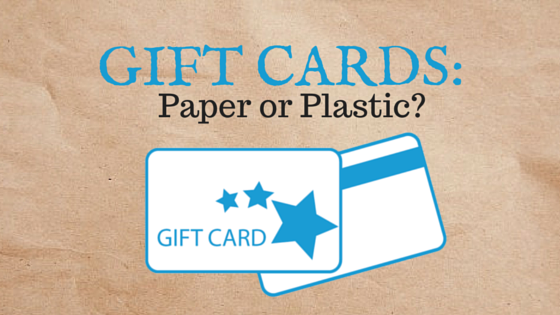Gift Cards: Paper or Plastic?
Their time has come – paper cards. Not to say they haven’t been around for a while, but the adoption of paper cards for advertising, and now gift, is growing significantly. According to the Gift Card Network’s 2014 Holiday Overview, 8% of in-store gift cards were paper. The key drivers for their adoption are cost, sensitivity to renewable resources and options for recycling products, the quality of new personalization printing, improvement of paper quality, and the ability to add magnetic stripes, which aids in their use in the gift card space.
So what are the main factors for choosing paper over plastic?
Cost. Without question paper cards can be provided in similar thicknesses to plastic cards from 15pt to 28pt or even 30pt. And, because of the number of printers knowledgeable with printing on paper, it is relatively easy to find a vendor that can print paper cards.
Eco-friendly. PVC has a pretty harsh reputation. For those customers looking for a more benign environmentally sensitive product, paper, especially on recycled paper or FSC (Forest Stewardship Council) paper can be a perfect fit.
Forest Stewardship Council certification gives customers the option to choose forest products like paper and wood that have been sourced in an environmentally-friendly, socially responsible and economically viable manner.
High Quality Personalization. The information printed on cards (account numbers, pin numbers, scratch-off, barcodes, etc.) can be very sensitive for both privacy and financial reasons. With the arrival of high-speed drop-on-demand (DOD) inkjets, cards can be produced in secure environments with the best quality personalization available. Previously, high quality printing was only available on short-run printers dedicated to the financial marketplace and the PVC solution.
Paper Quality. There is a rich variety of options for paper which really doesn’t exist for plastic products. High end cards are stiffer, more durable, and whiter. There are still lower cost options as well, but the advent of paper manufactures competing to bring out the best replacement for PVC has led to a broad range of acceptable solutions that fit any marketers need.
Magnetic Stripes. In the last few years, the industry has perfected applying magnetic stripes to paper, just as they always have for plastic cards. They work just fine for single or few-use cards, and can be encoded normally with close to the same quality specifications as magnetic stripes laid down on plastic cards.
In spite of all of these advances and advantages, this is still some sacrifice in using paper over plastic. First, paper cards cannot be embossed or effectively tipped (color applied to the raised letters and numbers). Embossing is still the #1 tool for some marketers in getting customers to open envelopes. Embossed cards add a perceived value that improves lift, while a flat-printed card may reduce open rates since it doesn’t mimic the feel of a valued credit card. And, even though the durability of paper has improved, it is, well, still paper! Subject to wear and tear, affects from moisture and heat, paper is not a good choice for cards that might be carried and or used over many months or years.
CPS Cards provides end-to-end card printing solutions for both plastic and paper cards. We can help you navigate the world of cards and determine which card is right for you – paper or plastic. Visit us at www.cpscards.com to learn more.
